| Click On Image For Full Size | Size | Image Description | Source | |
|---|---|---|---|---|
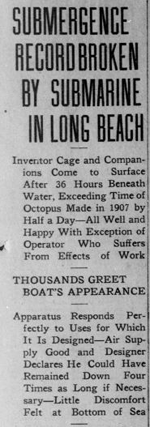 |
9.29k | The actual construction of the Cage submarine was begun 25 November 1911 at the Craig shipbuilding plant. This is the invention of a Long Beach man and is said to embody many ideas new in submarine construction. SUBMERGENCE RECORD BROKEN BY SUBMARINE IN LONG BEACH Inventor Cage and Companions Come to Surface After 36 Hours Beneath Water, Exceeding Time of Octopus (SS-9) Made in 1907 by Half a Day - All Well and Happy With Exception of Operator Who Suffers From Effects of Work. | Image and text provided by University of California, Riverside. Photo from The San Francisco Call. (San Francisco [Calif.]) 1895-1913, 25 November 1911, Image 25, & 12 June 1913, Images 1 & 2 via chroniclingamerica.loc.gov. | |
 |
644k | Cage submarine surfacing off Long Beach, 29 June 1912. Real photo postcard. | Photo courtesy of David Wright. | |
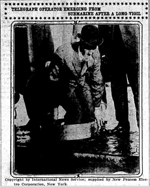 |
2.76k | TELEGRAPH OPERATOR EMERGING FROM SUBMARINE AFTER A LONG VIGIL. Never Slept During Entire Time Submarine Was Under Water During Which Time He Sent Out to the World Above Over One Thousand Bulletins. |
Image and text provided by Minnesota Historical Society; Saint Paul, MN. Photo & text by The Bemidji Daily Pioneer. (Bemidji, Minn.) 1904-1971, 21 June 1913, Image 1, courtesy of chroniclingamerica.loc.gov. |
|
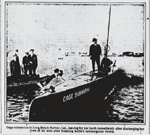 |
1.90k | In Record Breaking Submergence Test Inventor Proves Value of Gasoline in Submarines Cage Submarine in Long Beach Harbor, Cal. leaving for her berth immediately after discharging her crew of six men after breaking world's submergence record. |
Image and text provided by The New York Public Library, Astor, Lenox and Tilden Foundation. Photo & text by The Sun. (New York [N.Y.]) 1833-1916, 12 June 1913, Image 1 & 29 June 1913, SIXTH SECTION, Image 58, courtesy of chroniclingamerica.loc.gov. |
|
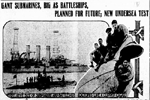 |
827k | GIANT SUBMARINES, BIG AS BATTLESHIPS, PLANNED FOR FUTURE; NEW UNDERSEA TEST Will the submarine eventually put the super-Dreadnought out of business? This question is a live topic just now for two reasons. The first is the decision of Congress to build much larger undersea fighters. The second is the success of the Benton in setting a new record for staying under water at Long Beach, Cal....The submarine Benton is a new type invented by John M. Cage... |
Image and text provided by State Historical Society of North Dakota. Photo & text by Bismarck Daily Tribune. (Bismarck, Dakota [N.D.]) 1881-1916, 15 June 1913, Image 1, courtesy of chroniclingamerica.loc.gov. |
|
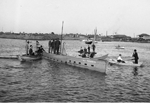 |
384k | Cage Submarine in Long Beach Harbor, Cal. | Photo courtesy of jbpics@flickr.com viaDavid Johnston (USN, retired) | |
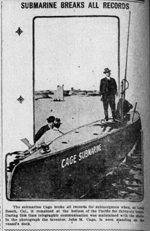 |
727k | SUBMARINE BREAKS ALL RECORDS I get the impression that the main reason that Cage/Neff system failed was one of scalability. This link will take you to a copy of Friedman's U.S. Submarines Through 1945. On page 119 at the bottom of the left hand column is a reference to the size of the Neff boat. A 150 ton boat would be approximately the size of a B-class. This is a very small boat even for 1916. Friedman states pretty firmly that this was to be SS-108. Also check out page 76. There is further info on Neff system tests conducted on N-2. Friedman mentions in a footnote in his book that the Navy offered a K-class boat for trials, but this was enventually turned down due to concerns about availability of boats for war duties. On a small boat with relatively low powered gasoline or diesel engines the idea of supplying air to the engines from compressed air banks might work. But as the engines got more and more powerful, it quickly became apparent that it was impossible to store enough air to run the engines for any length of time. For the same reason, the idea of dealing with the exhaust by condensing, compressing, then pumping it over the side lost practicality as you scaled up the engines. Handling the toxic exhaust gasses without leaks in the sealed hull of a submarine must have been a real issue as well. Can you imagine how much compressed air would be needed to run just one of the big GM-Winton V-16's or the Fairbanks Morse 9 cylinder rock crushers of the fleet boats, let alone four? I am not completely immersed in the scientific principal, but I believe there was an issue with the amount of energy inherent in compressed air versus an electrical storage battery. True, while air banks a quite a bit lighter than batteries, for the amount of space taken up (about the same for air banks or batteries), batteries were a lot more efficient and provided more energy and therefore more horsepower. Friedman states that "Neff eventually proposed to use the diesels only for high speed; at lower speeds, the boat would run on compressed air. High-speed underwater endurance would far exceed that offered by conventional batteries because the fuel contributed so much energy. Compressed air could not store as much energy as chemicals in a battery, however, at 5 kt Neff managed only half the endurance of an S-boat." The Cage/Neff system gained some favor early on due to the rather primitive state and unreliability of electrical systems and storage batteries at the time. The batteries were fairly low powered and heavy and were very gassy when being charged. The battery acid was also a major hazard, as evidenced by the F-4 disaster. There was a strong desire to get around these limitations, thus the interest in Neff's system. Unfortunately, at about the same time Neff was pushing his system, there were rapid advances being made in electrical technology development. These advances made the scalability problem even more acute and they quickly made the Neff system appear to be dangerous and problematic. Batteries simply had far more potential for development. It is ironic that a system intended to make submarines safer and simpler was so quickly overcome by other technological developments that it came to be seen as dangerous and problematic itself. Neff was making a very early attempt at a closed-loop propulsion system that would allow high submerged speeds and endurance as well as increase safety. Unfortunately the technology of the time wouldn't support it and science was against it. It would take later developments of the Walter hydrogen peroxide principal and the rise of nuclear power before this dream could be realized. Note: The following patent was granted to Neff in 1932 for a much larger submarine. This document is what lead me to believe that Neff did not immediately give up after he was rejected by the General Board in 1922. There are no dimensions listed for this boat, but it appears to be approximately H or K-class in size. |
Text courtesy of David Johnston Image and text provided by Louisiana State University; Baton Rouge, LA Photo & text by Tensas Gazette.(St. Joseph, La.) 1886-current, 01 August 1913, Image 6, courtesy of chroniclingamerica.loc.gov | |
 |
656k | Cut out of the Cage/Neff submarine. | Photo courtesy of The Popular Science Monthly, Volume 88. Link courtesy of David Johnston (USN, retired) Photo fix by Tom Kermen. | |
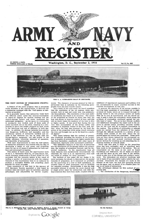 |
410k | Cage Submarine in Long Beach Harbor, Cal. from the Army & Navy Register, 2 September 1916. | Photo courtesy of Ron Reeves (of blessed memory). | |
Additional Resources and Web Sites of Interest
NINE COMPETITORS IN SUBMARINE BIDS
Scientific American, Volume 117
Hearings ... on estimates submitted by the secretary of the Navy, 1916, Volume 1
Neff's proposal for SS-108
| Back To The Main Photo Index | Back To the Submarine Index |
| Problems and site related matters, E-mail Webmaster |
| This page is created and maintained by David Johnston (USN, retired) & Michael Mohl All Pages © 1996 - 2025 NavSource History. All rights reserved. |